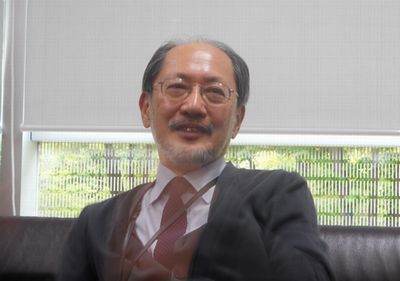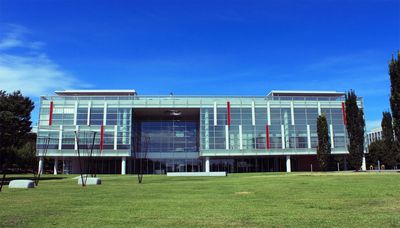No.090 - Interview with Dr. Kikuo MAEKAWA, a new Director-General of the National Institute for Japanese Language and Linguistics (Part 2)
Interview with Dr. Kikuo MAEKAWA,
a new Director-General of the National Institute for Japanese Language and Linguistics
In April 2023, Dr. Kikuo MAEKAWA was appointed as the new Director-General of the National Institute for Japanese Language and Linguistics. In part two of the interview, we asked the newly appointed Director-General about NINJAL’s regional cooperation, collaboration with other fields, and his aspirations as the new Director-General.
NINJAL’s regional cooperation
In terms of regional cooperation, we engage in low-key efforts to provide on-site instruction in response to requests from elementary, junior high, and high schools. Also, once a year we had been running a “Japanese Language Exploration” event where mainly elementary school students visit NINJAL and experience various language-related games and other activities, along with open house events for the general audience. Unfortunately, these events had to be held online over the past few years due to the COVID-19 pandemic, but since this only involves having people watch videos, they are insufficient as open house-style events, and I think it is better to have people actually visit NINJAL to talk with researchers or to have researchers answer their questions. At this point, I don’t know whether open house activities can be completely restored to what they were before the pandemic. In the future, I hope we can aim at strengthening cooperation with regional areas to a greater extent, but this is still in the exploratory stages. I wish we could hold workshops along the lines of “This is how researchers analyze the Japanese language” for the general audience as well as the regional audience.
NINJAL’s collaboration with other organizations
NINJAL’s collaboration with the Institute of Statistical Mathematics (“ISM” hereafter) goes way back to the 1950s. One of NINJAL’s often-cited accomplishments is a longitudinal survey of the standardization of dialects in Tsuruoka City in Yamagata Prefecture. During the first survey conducted in 1952, Professor Chikio HAYASHI, who was then a young researcher of ISM and would later serve as its Director-General, not only took part in the survey in the field but was also deeply involved in its design and methodologies. Even by world standards, the survey was the first instance of a sociolinguistic survey based on a rigid statistical sampling methodology. The survey was conducted with such rigor was largely due to the efforts of ISM researchers including Professor HAYASHI. NINJAL also conducted a joint survey with ISM on the island of Hachijo-jima in 1950. ISM had been established during the Second World War in 1944, while NINJAL was established in 1948. The two institutes began collaborating soon after their respective establishments.
NINJAL also has various dealings with the National Institute of Informatics (“NII” hereafter), reflecting the fact that language became an important topic in informatics. For example, in the 1992 third survey of Tsuruoka City, unlike the earlier two, an audio recording of the survey scene was done for the first time.
I edited all of those recordings and compiled them into a database, and the database was then publicly released using an NII organization known as theSpeech Resources Consortium. More recently NII has been of great help to NINJAL in the area of digital humanities (“DH” hereafter), and we are considering other avenues of collaboration.

Natural Sciences and Humanities
Indeed, I do believe there are clear differences between the natural sciences or engineering and the humanities. In the case of the CSJ, for instance, from an engineering standpoint, there was a clear goal from the outset of improving the speech recognition rate for spontaneous speech. The goal was a world in which this rate had been raised to the practical level. The CSJ project was planned “backward” from this goal, but that is not always the case with the humanities. There is a constant process of trial and error in various ways, where we uncover the research themes themselves through this exploration, and that differs quite sharply from the behaviors of natural scientists. I sometimes think that the essence of the humanities lies in the effort itself of uncovering those threads of research. I’m not sure how many people would agree with describing the humanities as being about discovering problems instead of solving them, but I think that the scope of the humanities would be too skinny if it were limited only to problem-solving.
In humanities, what a researcher wants to do must be curiosity-driven. Each researcher has their own interests and things they want to find out, and so they consider what specific analytical methods are available to learn that information. Without the right expertise, I don’t think things like the processing of DH data will go well. Those things have not been traditionally taught in graduate schools of humanities. That know-how does not need to be taught to everyone, but they are skills that people engaged in activities predicated on DH need to be familiar with, and I think this is something that will need to be incorporated into the curricula of linguistics graduate schools and similar institutions in the future.
Starting April 2023, NINJAL joined the Graduate University of Advanced Studies (SOKENDAI) and welcomed four enrollees into the Japanese Language Science course it administers. This is where we hope to cultivate the people who will take on this responsibility.
Even when researchers in the humanities and sciences take part in joint research of an interdisciplinary or “field-fusing” nature while knowing little of their counterparts, they may end up having only a very superficial understanding of their research theme, or even be led to outrageous conclusions. Conducting proper joint research requires some degree of basic knowledge about one another’s fields of expertise. That’s one reason why I think students should not be divided into science and humanities in high schools. Even in universities, we have done away with liberal arts departments. In other words, the idea is to have students devote all four years to specialized education. That doesn’t strike me as that good from a long-term perspective.
Aspirations as the new Director-General
NINJAL underwent a great deal of turmoil in October 2009 when it transitioned from being an independent administrative institute to an inter-university research institute corporation, but now the turmoil has settled down, and NINJAL has been reborn as an academic research institute. As the Fourth Medium-Term Plan instituted during the term of the former Director-General Yukinori TAKUBO has been well crafted, NINJAL researchers are steadily advancing the research plan they have established.
One thing I think I need to do while here is related to DH. DH is an effort being made by the National Institutes for the Humanities (“NIHU” hereafter) under the direction of President KIBE. This is certainly the right direction to take. NIHU overall continues to build a large trove of digital data related to language and Japanese culture, and this will become even more solid in the future. However, how to analyze that data is another story. I think we should be engaging in post-DH research methodology predicated on DH.
An enormous volume of data is already online and accessible at any time. This is a dream come true for an old student of humanities. Back then, unless you conducted fieldwork, read a manuscript, or borrowed books from a noted scholar to create your own data, there was no data available. In the era of DH, a significant portion of that data, if not all, is already online, and when you search for it, you can acquire a vast amount of data whose quality is guaranteed to a considerable degree. Given this, I think it will be extremely important to develop research methods related to how that data is arranged and combined. I believe those methodologies will definitely move in the direction of experimental methods that lean towards the natural sciences, and to modeling and simulation predicated on a certain degree of computing power being available.

(Interviewer: Nobuko KIBE, President, National Institutes for the Humanities)
(Text: Go OHBA, Researcher, Center for Innovative Research, National Institutes for the Humanities)
Kikuo MAEKAWA, Director-General, National Institute for Japanese Language and Linguistics specializes in phonetics and language resources. After studying linguistics at the Graduate School of Sophia University, he ended up earning his Ph.D. from the Graduate School of Information Science and Technology, Tokyo Institute of Technology. In 1984 he worked as an assistant in the Faculty of Education of Tottori University, and in 1987 as a lecturer in the same faculty. Since 1989 he has worked at the National Institute for Japanese Language and Linguistics, holding his current position since April 2023.
